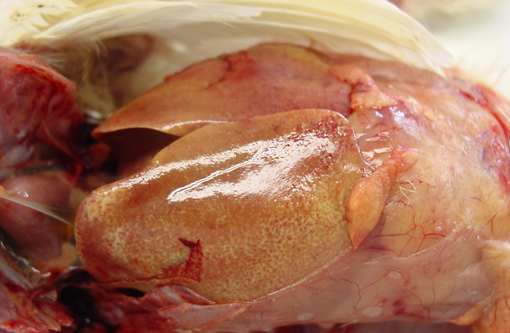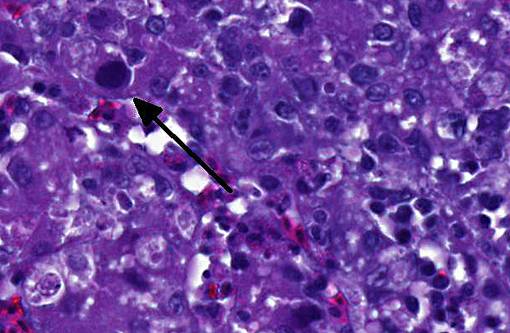Signalment:
Gross Description:
Histopathologic Description:
Morphologic Diagnosis:
Condition:
Contributor Comment:
The liver is the primary organ affected.(1) The infection produces a multifocal necrotizing hepatitis with intranuclear inclusion bodies in the hepatocytes.(1,6) Within the literature, the description of these intranuclear inclusion bodies is variable; inclusions have been described as large and eosinophilic or basophilic, or irregularly shaped, but they always replace/peripherally displace chromatin, and produce significant karyomegaly.(1)
JPC Diagnosis:
Conference Comment:
Members of the family Adenoviridae are non-enveloped, icosahedral, dsDNA viruses composed of four genera: Aviadenovirus (infects birds), Mastadenovirus (infects mammals), Atadenovirus (infects birds, mammals and reptiles) and Siadenovirus (infects birds, amphibians, reptiles); there is also a proposed fifth genus that includes adenoviruses of fish, such as white sturgeon adenovirus. Adenoviruses characteristically produce viral inclusion bodies within the host cell nucleus, where replication occurs.(4) Readers are urged to review WSC 2009-2010, Conference 9, case 3 for additional details regarding general characteristics of adenoviruses. See table 1 for a summary of select adenoviruses significant in veterinary medicine.
Important aviadenoviruses (subgroup I) include inclusion body hepatitis virus, quail bronchitis virus and hydropericardium syndrome virus. Turkey adenovirus 3, the causative agent of hemorrhagic enteritis in turkeys, marble spleen disease in pheasants and avian adenovirus splenomegaly in broilers, is a siadenovirus (subgroup II), while egg drop syndrome virus is a member of the genus Atadenovirus (subgroup III).1 The pathogenesis of subgroup I avian adenoviruses is less defined than that of subgroups II and III; however, in general, both vertical and horizontal (especially fecal-oral) transmission are thought to be important in all aviadenoviruses. As noted by the contributor, IBH virus primarily targets hepatocytes, but pancreatic lesions are reported as well. Infection tends to occur in 3-7 week old broiler chickens (although it has been reported in birds as young as 7 days and as old as 20 weeks) resulting in up to 30% mortality. It often occurs as a secondary infection in immunodeficient birds with other diseases, predominantly infectious bursal disease (birnavirus, serotype 1) and chicken infectious anemia (circovirus). Outbreaks of IBH with similar gross and histological lesions have also been reported in columbiformes, psittacines and raptors.(1)
The recently identified falcon adenovirus, which is distantly related to fowl adenovirus types 1 and 4 (see WSC 2007-2008, Conference 23, case 3) rarely causes necrotizing hepatitis and splenitis with characteristic intranuclear viral inclusions; stress related to shipping or breeding is a likely predisposing factor for clinical disease.(2) Quail bronchitis virus, caused by avian adenovirus 1, is a worldwide disease of both captive and wild bobwhite quail; birds present with respiratory distress, nasal discharge, coughing, sneezing, conjunctivitis and, occasionally in older birds, diarrhea. Mortality approaches 100% in the young, but falls below 25% in those older than 4 weeks. Microscopic findings include tracheitis, air sacculitis and enteritis, with characteristic intranuclear viral inclusions. Infection with fowl adenovirus type 4 is believed to be the cause of hydropericardium syndrome virus (Angara disease), which is found in the Middle East as well as South America; particularly severe manifestations are also associated with immunosuppression. Lesions include pericardial effusion, pulmonary edema, hepatomegaly and renomegaly; mortality can range from 20-80%; and affected broilers are usually 3-5 weeks old.(4)
Egg drop syndrome, an atadenovirus (subgroup III) recognized in chickens, ducks and geese results in the production of soft-shelled or shell-less eggs. It is suspected that the virus originated in ducks and was passed to chickens via contaminated Mareks disease vaccine produced with duck embryo fibroblasts; spread within flocks occurs through contaminated eggs, droppings and fomites. Egg drop syndrome has worldwide distribution except the United States and Canada. The siadenovirus (subgroup II), turkey adenovirus 3, produces splenomegaly, hemorrhagic enteritis and immunosuppression with secondary opportunistic infections in turkeys older than 4 weeks. A serologically identical virus also causes marble spleen disease in pheasants and splenomegaly in chickens. Microscopic lesions are similar in all species and include splenic reticuloendothelial hyperplasia with intranuclear viral inclusions and fibrinonecrotic, hemorrhagic enteritis. There is a vaccine available.(4)
Table 1: Select adenoviruses in veterinary species.(1,4)
| Species | NameSpecies | Comment |
| Dogs | Canine adenovirus 1 Canine adenovirus 2 (mastadenovirus) | - Infectious canine hepatitis - Infectious canine tracheobronchitis |
| Horses | Equine adenovirus 1 & 2 (mastadenovirus) | - Asymptomatic or mild respiratory disease in immunocompetent hosts - Bronchopneumonia/systemic disease in Arabian foals with SCID |
| Cattle | Bovine adenovirus (mastadenovirus and atadenovirus) | - 10 serotypes - Asymptomatic or mild respiratory disease - Occasionally pneumonia, enteritis, keratoconjunctivitis in calves |
| Swine | Porcine adenovirus (mastadenovirus) | - 4 serotypes - Asymptomatic or mild respiratory disease/enteritis; rarely encephalitis |
| Sheep | Ovine adenovirus (mastadenovirus and atadenovirus) | - 7 serotypes - Asymptomatic or mild respiratory disease - Occasionally severe respiratory/enteric disease in lambs |
| Goats | Caprine adenovirus (mastadenovirus and atadenovirus) | - 2 serotypes - Asymptomatic or mild respiratory disease |
| Deer | Cervine adenovirus (Odocoileus adenovirus 1; atadenovirus) | - Vasculitis, hemorrhage, pulmonary edema |
| Rabbits | Adenovirus 1 (mastadenovirus) | - Diarrhea |
| Mice | Murine adenovirus 1 & 2 (mastadenovirus) | - Murine adenovirus 1: experimental infections - Murine adenovirus 2: enterotropic; causes runting in neonates |
| Guinea pigs | Guinea pig adenovirus (mastadenovirus) | - Usually asymptomatic; rarely pneumonia with high mortality, low morbidity |
| Chickens | Fowl adenovirus (aviadenovirus, atadenovirus and siadenovirus) | - 12 serotypes of aviadenovirus (inclusion body hepatitis, hydropericardium syndrome)
- 1 serotype of atadenovirus (egg drop syndrome) - 1 serotype of siadenovirus (adenovirus-associated splenomegaly) |
| Turkeys | Turkey adenovirus 1-3 (siadenovirus and aviadenovirus) | - turkey adenovirus 3, siadenovirus (hemorrhagic enteritis, egg drop syndrome) - turkey adenovirus 1 & 2, aviadenovirus (depressed egg production) |
| Quail | Avian adenovirus 1 (aviadenovirus) | - 1 serotype, aviadenovirus (bronchitis) |
| Pheasants | - serologically indistinguishable from Turkey adenovirus 3 (siadenovirus) | - Siadenovirus (marble spleen disease) |
| Ducks | Duck adenovirus 1 & 2 (atadenovirus and aviadenovirus) | - 1: atadenovirus (asymptomatic or drop in egg production) - 2: aviadenovirus (rare hepatitis) |
References:
2. Dean J, Latimer KS, Oaks JL, Schrenzel M, Redig PT, W+�-+nschmann A. Falcon adenovirus infection in breeding Taita falcons (Falco fasciinucha). J Vet Diagn Invest. 2006;18:282-286.
3. Hollell J, McDonald DW, Christian RG. Inclusion body hepatitis in chickens. Can Vet J. 1970;11:99-101.
4. MacLachlan NJ, Dubovi EJ. Fenners Veterinary Virology. 4th ed. London, UK: Academic Press; 2011:203-212.
5. Ramis A, Marlasca MJ, Majo N, Ferrer L. Inclusion body hepatitis (IBH) in a group of Eclectus parrots (Eclectus roratus). Avian Pathol. 1992;21(1):165-169.
6. Randall CJ, Reece RL. Color Atlas of Avian Histopathology. Mosby-Wolfe, Times Mirror International Publishers Limited; 1996:95-96.

